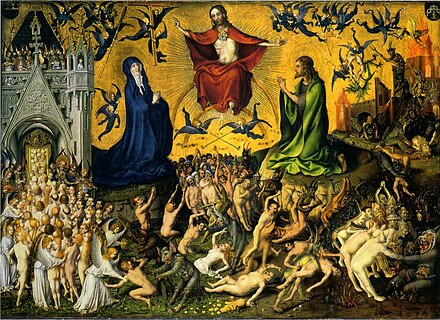The Last Judgement (Martin paintings)
The Last Judgement is a triptych of oil paintings by the British artist John Martin, created in 1851–1853. The work comprises three separate paintings on a theme of the end of the world, inspired by the Book of Revelation. The paintings, The Plains of Heaven, The Last Judgement, and The Great Day of His Wrath, are generally considered to be among Martin's most important works, and have been described by some art critics as his masterpiece.
The paintings were Martin's last major works before his death in 1854. They were exhibited to the public from the time of his death until the 1870s to advertise the sale of prints from engravings of the works, being displayed in galleries and exhibition halls all over the UK, in New York in 1856–57 and in Australia in 1878–79. It has been claimed that up to eight million people viewed the paintings during their extensive tours.
Martin's style of didactic expository art was rarely praised by art critics but remained popular with the public until the 1860s. He fell out of style by the end of the 19th century, and his works were pigeonholed as Victorian and religious by the early 20th century.
Critical opinion of Martin's work improved from the 1940s, and the Tate Gallery bought The Great Day of His Wrath in 1945. The triptych was reassembled at the Tate Gallery in 1974 after Charlotte Frank donated the two other works following the death of her husband, Robert Frank. The paintings were the cornerstone of the first substantial exhibition of Martin's works at the Tate Britain in 2011–12, with a theatrical son et lumière show dramatising the manner of their exhibition in Victorian Britain.
| The Last Judgement | ||
 |  |  |
| The Plains of Heaven | The Last Judgement | The Great Day of His Wrath |

最後の審判三部作之一:神の大いなる怒りの日。ジョン・マーティン作

最後の審判三部作之二:最後の審判。ジョン・マーティン作

最後の審判三部作之三:天国の平原。ジョン・マーティン作
The Last Judgment[a] or The Day of the Lord (Hebrew: יום הדין, romanized: Yom ha-din, Arabic: یوم القيامة, romanized: Yawm al-qiyāmah, lit. 'Day of Resurrection' or Arabic: یوم الدین, romanized: Yawm ad-din, lit. 'Day of Judgement') is part of the eschatological world view of the Abrahamic religions and in the Frashokereti of Zoroastrianism.
Some Christian denominations consider the Second Coming of Christ to be the final and infinite judgment by God of the people in every nation[1] resulting in the approval of some and the penalizing of others. The concept is found in all the Canonical gospels, particularly the Gospel of Matthew. Christian Futurists believe it will take place after the Resurrection of the Dead and the Second Coming of Christ while Full Preterists believe it has already occurred. The Last Judgment has inspired numerous artistic depictions.



沒有留言:
張貼留言